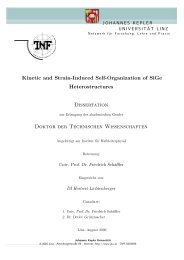Diplomarbeit Diplom-Ingenieur - Institut für Halbleiter
Diplomarbeit Diplom-Ingenieur - Institut für Halbleiter
Diplomarbeit Diplom-Ingenieur - Institut für Halbleiter
Create successful ePaper yourself
Turn your PDF publications into a flip-book with our unique Google optimized e-Paper software.
16<br />
There are two important, adjustable apertures between the objective and<br />
intermediate lens. The first is the objective aperture, which is located at the level of<br />
the focal plane and allows the selection of electrons from distinct scattered beams for<br />
image formation. The other is placed in the image plane of the objective lens and acts<br />
as a virtual aperture to choose the area of interest on the sample. It is called field-<br />
limiting aperture or selected area diffraction aperture (SAD).<br />
The JEOL JEM 2011 FastTem uses a LaB6 filament as electron source and the<br />
electrons can be accelerated up to 200keV between the Wehnelt cylinder and the<br />
anode plates. Electrons with an energy of 200keV are in the range where relativistic<br />
effects are playing a role. This leads to a wavelength of the particles of 2.5·10 -2 Å.<br />
The microscope is an electron system, thus the theoretical diffraction limit is given by<br />
the Rayleigh criterion (eqn. 3.1) [32].<br />
The denominator of equation 3.1 is called the numerical aperture and is the product of<br />
the diffraction-index and sin β, whereas β is the semiangle of collection. λ refers to<br />
the wavelength of the electrons. For an electron energy of 200keV this wavelength is<br />
2.5·10 -2 Å. The maximum resolution (the numerical aperture is set to 1) is then<br />
1.53·10 -2 Å.<br />
0.<br />
61⋅<br />
λ<br />
δ =<br />
n ⋅sin<br />
β<br />
The practical resolution is much worse than the theoretical diffraction limit. The<br />
main reasons are lens aberrations and in particular the spherical aberration of the<br />
magnetic lenses (see Fig. 3.3) [32]. The spherical aberration causes a stronger bend of<br />
off-axis electrons toward the optical axis, and thus a spot is reproduced as a disk in the<br />
image plane. The radius of this disk is given by Csβ 3 . β is again the semiangle of<br />
collection and Cs the spherical aberration coefficient, which is an important<br />
characteristic of a TEM. With this value and the Rayleigh criterion one can estimated<br />
a practical point-to-point resolution (eqn. 3.2) [32] of the microscope.<br />
r<br />
min<br />
≈ s<br />
( ) 4<br />
1<br />
3<br />
C<br />
0. 91 λ<br />
(3.1)<br />
(3.2)











